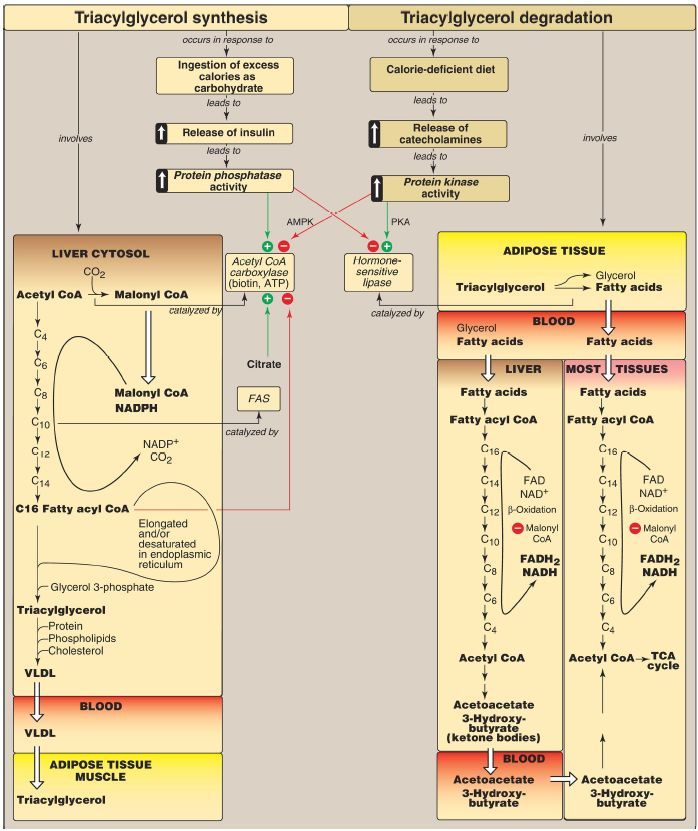
Summary of fatty acid
 المؤلف:
Denise R. Ferrier
المؤلف:
Denise R. Ferrier
 المصدر:
Lippincott Illustrated Reviews: Biochemistry
المصدر:
Lippincott Illustrated Reviews: Biochemistry
 الجزء والصفحة:
الجزء والصفحة:
 12-10-2021
12-10-2021
 1467
1467
Summary of fatty acid
A fatty acid, generally a linear hydrocarbon chain with a terminal carboxyl group, can be saturated or unsaturated. Two unsaturated fatty acids are dietary essentials: linoleic and α-linolenic acids. Fatty acids are synthesized in the liver cytosol following a meal containing excess carbohydrate and protein.
Carbons used to synthesize fatty acids are provided by acetyl coenzyme A (CoA), energy by ATP, and reducing equivalents by nicotinamide adenine dinucleotide phosphate ([NADPH], Fig. 1) provided by the pentose phosphate pathway and malic enzyme.
Citrate carries two-carbon acetyl units from the mitochondrial matrix to the cytosol. The regulated step in fatty acid synthesis is the carboxylation of acetyl CoA to malonyl CoA by biotin- and ATP-requiring acetyl CoA carboxylase (ACC). Citrate allosterically activates ACC, and palmitoyl CoA inhibits it. ACC can also be activated by insulin and inactivated by adenosine monophosphate–activated protein kinase (AMPK) in response to epinephrine, glucagon, or a rise in AMP.
The remaining steps in fatty acid synthesis are catalyzed by the multifunctional enzyme, fatty acid synthase, which produces palmitoyl CoA by adding two-carbon units from malonyl CoA to a series of acyl acceptors. Fatty acids can be elongated and
desaturated in the smooth endoplasmic reticulum (SER). When fatty acids are required for energy, hormone-sensitive lipase (activated by epinephrine, and inhibited by insulin), along with other lipases, degrades triacylglycerol (TAG) stored in adipocytes. The fatty acid products are carried by serum albumin to the liver and peripheral tissues, where their oxidation provides energy.
The glycerol backbone of the degraded TAG is carried by the blood to the liver, where it serves as a gluconeogenic precursor. Fatty acid degradation (β-oxidation) occurs in mitochondria. The carnitine shuttle is required to transport long-chain fatty acids from the cytosol to the mitochondrial matrix. A translocase and the enzymes carnitine palmitoyltransferases (CPT) I and II are required. CPT-I is inhibited by malonyl CoA, thereby preventing simultaneous synthesis and degradation of fatty acids. Mitochondrial fatty acid β-oxidation produces acetyl CoA, nicotinamide adenine dinucleotide (NADH), and flavin adenine dinucleotide (FADH2).
The first step in β-oxidation is catalyzed by one of four acyl CoA dehydrogenases, each with chain-length specificity. Medium-chain fatty acyl CoA dehydrogenase (MCAD) deficiency causes a decrease in fatty acid oxidation (process stops once a medium-chain fatty acid is produced), resulting in hypoketonemia and severe hypoglycemia. Oxidation of fatty acids with an odd number of carbons proceeds two carbons at a time (producing acetyl CoA) until three-carbon propionyl CoA remains. This compound is carboxylated to methylmalonyl CoA (by biotiand ATP-requiring propionyl CoA carboxylase), which is then converted to succinyl CoA (a gluconeogenic precursor) by vitamin B12-requiring methylmalonyl CoA mutase. A genetic error in the mutase or vitamin B12 deficiency causes methylmalonic acidemia and aciduria.
β-Oxidation of unsaturated fatty acids requires additional enzymes. β-Oxidation of verylong- chain fatty acids and α-oxidation of branched-chain fatty acids occur in the peroxisome. Deficiencies result in X-linked adrenoleukodystrophy and Refsum disease, respectively. ω-Oxidation, normally a minor pathway, occurs in the SER. Liver mitochondria can convert acetyl CoA derived from fatty acid oxidation into acetoacetate and 3-hydroxybutyrate (ketone bodies). Peripheral tissues possessing mitochondria can oxidize 3-hydroxybutyrate to acetoacetate, which can be cleaved to two acetyl CoA, thereby producing energy for the cell. Unlike fatty acids, ketone bodies are utilized by the brain and, therefore, are important fuels during a fast.
Because the liver lacks thiophorase required to degrade ketone bodies, it synthesizes them specifically for the peripheral tissues. Ketoacidosis occurs when the rate of ketone body formation is greater than the rate of use, as is seen in cases of uncontrolled type 1 diabetes mellitus.

Figure 1: Key concept map for fatty acid and triacylglycerol metabolism. AMPK = adenosine monophosphate–activated protein kinase; PKA = protein kinase A; CoA = coenzyme A; NADP(H) = nicotinamide adenine dinucleotide phosphate; FAD(H2) = flavin adenine dinucleotide; FAS = fatty acid synthase; CO2 = carbon dioxide; NAD(H) = nicotinamide adenine dinucleotide; TCA = tricarboxylic acid; VLDL = very-low-density lipoprotein.
 الاكثر قراءة في الكيمياء الحيوية
الاكثر قراءة في الكيمياء الحيوية
 اخر الاخبار
اخر الاخبار
اخبار العتبة العباسية المقدسة


